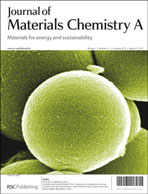Fabrication and enhanced dielectric properties of graphene–polyvinylidene fluoride functional hybrid films with a polyaniline interlayer
Abstract
Graphene–polyvinylidene fluoride hybrid films (GPNs–PVDF) with a polyaniline (PANI) interlayer are fabricated by a facile and effective process. The morphology of the graphene–polyaniline nanoflakes (GPNs) is examined by scanning electron microscopy (SEM) and transmission electron microscopy (TEM) and the interaction between graphene and PANI is investigated by Fourier transform infrared spectroscopy (FTIR), UV-visible spectroscopy, X-ray diffraction (XRD), and X-ray photoelectron spectroscopy (XPS). The GPNs have a layered structure resembling a cake with the graphene sheets sandwiched between the PANI layers. The GPNs have a uniform morphology which can be controlled by adjusting the ratio of PANI to graphene. The PANI inter-layer plays an active role in the dielectric properties of the GPNs–PVDF composites which have low dielectric loss, high breakdown field, and large energy density. The enhanced dielectric performance originates from the insulating PANI layer which not only ensures good dispersion of graphene sheets in the PVDF but also acts as an inter-particle barrier to prevent direct contact with the graphene sheets.


 Please wait while we load your content...
Please wait while we load your content...